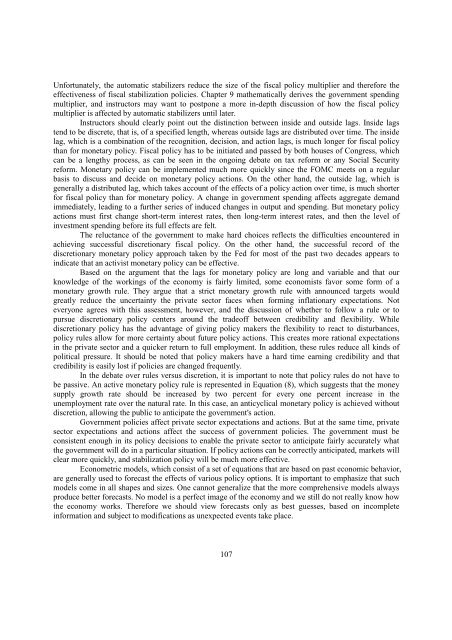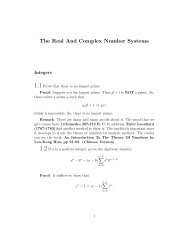Fiscal and monetary policy lags ⢠Automatic stabilizers ...
Fiscal and monetary policy lags ⢠Automatic stabilizers ...
Fiscal and monetary policy lags ⢠Automatic stabilizers ...
Create successful ePaper yourself
Turn your PDF publications into a flip-book with our unique Google optimized e-Paper software.
Unfortunately, the automatic <strong>stabilizers</strong> reduce the size of the fiscal <strong>policy</strong> multiplier <strong>and</strong> therefore theeffectiveness of fiscal stabilization policies. Chapter 9 mathematically derives the government spendingmultiplier, <strong>and</strong> instructors may want to postpone a more in-depth discussion of how the fiscal <strong>policy</strong>multiplier is affected by automatic <strong>stabilizers</strong> until later.Instructors should clearly point out the distinction between inside <strong>and</strong> outside <strong>lags</strong>. Inside <strong>lags</strong>tend to be discrete, that is, of a specified length, whereas outside <strong>lags</strong> are distributed over time. The insidelag, which is a combination of the recognition, decision, <strong>and</strong> action <strong>lags</strong>, is much longer for fiscal <strong>policy</strong>than for <strong>monetary</strong> <strong>policy</strong>. <strong>Fiscal</strong> <strong>policy</strong> has to be initiated <strong>and</strong> passed by both houses of Congress, whichcan be a lengthy process, as can be seen in the ongoing debate on tax reform or any Social Securityreform. Monetary <strong>policy</strong> can be implemented much more quickly since the FOMC meets on a regularbasis to discuss <strong>and</strong> decide on <strong>monetary</strong> <strong>policy</strong> actions. On the other h<strong>and</strong>, the outside lag, which isgenerally a distributed lag, which takes account of the effects of a <strong>policy</strong> action over time, is much shorterfor fiscal <strong>policy</strong> than for <strong>monetary</strong> <strong>policy</strong>. A change in government spending affects aggregate dem<strong>and</strong>immediately, leading to a further series of induced changes in output <strong>and</strong> spending. But <strong>monetary</strong> <strong>policy</strong>actions must first change short-term interest rates, then long-term interest rates, <strong>and</strong> then the level ofinvestment spending before its full effects are felt.The reluctance of the government to make hard choices reflects the difficulties encountered inachieving successful discretionary fiscal <strong>policy</strong>. On the other h<strong>and</strong>, the successful record of thediscretionary <strong>monetary</strong> <strong>policy</strong> approach taken by the Fed for most of the past two decades appears toindicate that an activist <strong>monetary</strong> <strong>policy</strong> can be effective.Based on the argument that the <strong>lags</strong> for <strong>monetary</strong> <strong>policy</strong> are long <strong>and</strong> variable <strong>and</strong> that ourknowledge of the workings of the economy is fairly limited, some economists favor some form of a<strong>monetary</strong> growth rule. They argue that a strict <strong>monetary</strong> growth rule with announced targets wouldgreatly reduce the uncertainty the private sector faces when forming inflationary expectations. Noteveryone agrees with this assessment, however, <strong>and</strong> the discussion of whether to follow a rule or topursue discretionary <strong>policy</strong> centers around the tradeoff between credibility <strong>and</strong> flexibility. Whilediscretionary <strong>policy</strong> has the advantage of giving <strong>policy</strong> makers the flexibility to react to disturbances,<strong>policy</strong> rules allow for more certainty about future <strong>policy</strong> actions. This creates more rational expectationsin the private sector <strong>and</strong> a quicker return to full employment. In addition, these rules reduce all kinds ofpolitical pressure. It should be noted that <strong>policy</strong> makers have a hard time earning credibility <strong>and</strong> thatcredibility is easily lost if policies are changed frequently.In the debate over rules versus discretion, it is important to note that <strong>policy</strong> rules do not have tobe passive. An active <strong>monetary</strong> <strong>policy</strong> rule is represented in Equation (8), which suggests that the moneysupply growth rate should be increased by two percent for every one percent increase in theunemployment rate over the natural rate. In this case, an anticyclical <strong>monetary</strong> <strong>policy</strong> is achieved withoutdiscretion, allowing the public to anticipate the government's action.Government policies affect private sector expectations <strong>and</strong> actions. But at the same time, privatesector expectations <strong>and</strong> actions affect the success of government policies. The government must beconsistent enough in its <strong>policy</strong> decisions to enable the private sector to anticipate fairly accurately whatthe government will do in a particular situation. If <strong>policy</strong> actions can be correctly anticipated, markets willclear more quickly, <strong>and</strong> stabilization <strong>policy</strong> will be much more effective.Econometric models, which consist of a set of equations that are based on past economic behavior,are generally used to forecast the effects of various <strong>policy</strong> options. It is important to emphasize that suchmodels come in all shapes <strong>and</strong> sizes. One cannot generalize that the more comprehensive models alwaysproduce better forecasts. No model is a perfect image of the economy <strong>and</strong> we still do not really know howthe economy works. Therefore we should view forecasts only as best guesses, based on incompleteinformation <strong>and</strong> subject to modifications as unexpected events take place.107
















